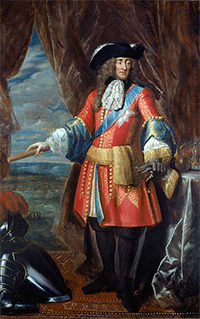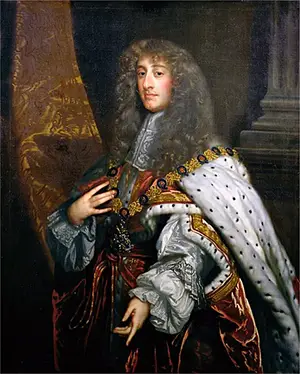King James II of England
James II was King of England for a few years in the late 17th Century. A staunch Catholic, he retried to return England to a Catholic realm and was rebuffed and eventually replaced on the throne. He was born on Oct. 14, 1633. His father was King Charles, and his mother was Queen Henrietta Maria, a French princess. 
Young James eventually fled to Continental Europe during the English Civil Wars, which involved his father and his supporters fighting against members of Parliament and their supporters. He had first accompanied Charles in the first major battle, at Edgehill, but was nearly captured and sought refuge in the Royalist stronghold of Oxford. When Parliamentarian forces besieged that city, James fled the country, at one point disguising himself as a woman to avoid detection. He fought in the French army and in the Spanish army for a time and then returned to England in 1660, when his brother, Charles, was recalled and became King Charles II. One of James's first duties after his brother was crowned was to command the Royal Navy. He held this post until 1673. He was in command during the last two Anglo-Dutch Wars. James was also Duke of York, a title he had been given while his father was still alive. (When British troops captured New Netherland in North America in 1664, they restyled the name of the city, naming it after James, the Duke of York.) This time around, James was heavily involved in the African slave trade, in that he was head of the Royal African Company. He also played a large role in fighting the fires that made up the Great Fire of London in 1666. In 1669, James decided to embrace the Roman Catholic faith. Tensions over religious beliefs had been high in England for nearly 200 years, after King Henry VIII broke with the Catholic Church and declared himself head of the Church of England. Henry's son and successor, Edward I, had presided over a strong embrace of Protestantism, including the introduction of a Book of Common Prayer and a number of laws requiring people in England to ascribe to Protestant beliefs. The next English monarch, Edward's sister Mary I, was a devout Catholic and sought to restore her faith to supremacy in England. Her sister and successor, Elizabeth I, turned the tables again, embracing the Protestant faith. Charles I had angered many in his realm by not only marrying a Catholic princess but also getting involved in the Thirty Years War, which was, in part, a war of Catholic vs. Protestant. And when Charles II became king, he was very careful not to antagonize those who agreed to call him back to England by openly stating his secret Catholic sympathies. (Charles II, it turned out, converted to the Catholic faith just before he died.) And so when James declared himself a Catholic in 1669, he became all the more of a problem in the eye of many English Protestants because Charles and his wife, Catherine, did not have any children and so James was the presumptive heir to the throne. When Charles died, in 1685, James did indeed ascend to the throne. As it turned out, Charles did have a son, whose mother was not the queen. This was the Duke of Monmouth, who declared himself Charles's rightful heir not long after James took the throne and led an armed rebellion against the new king. James's army had no trouble dispatching the rebels, defeating them at the Battle of Sedgemoor, and the king had Monmouth executed. 
Also as it turned out, James was not at all willing to declare the Church of England the effective sole faith of the realm. He wanted Catholics to have more rights and more of a public ability to worship the way that they wanted to. Parliament did not agree with such measures, and James dissolved Parliament. He then appointed known Catholics to high-ranking posts within the government and the military. He went a step further in 1687 by issuing a Declaration of Indulgence, which granted complete religious toleration. He also, after Monmouth's rebellion, had the Archbishop of Canterbury arrested and tried for sedition. (Sympathetic courts acquitted them.) Adding to the unrest was a large influx of Huguenot immigrants. These Protestants had been given protection to live in France and worship the way they wanted to in the Edict of Nantes, issued by France's King Henry IV in 1598. Henry's grandson, Louis XIV, however, issued his own edict, the Edict of Fontainebleau, which revoked the Edict of Nantes and opened up Huguenots to religious persecution in France. As a result, Huguenots in the hundreds of thousands fled to other countries, most notably Britain. Protestant by nature, they would not have appreciated James's Catholics-first pronouncements. James had married Anne Hyde, the daughter of his brother's chief minister, in 1660. They had two children, Mary and Anne. Anne (James's wife) died in 1671. James married Mary of Modena, an Italian teenage princess. In June 1688, he and Mary had a son, named James. A group of Protestant nobles had had enough of James and his favoritism toward Catholics, and they saw in the king's son a succession of Catholic monarchs. The solution, as these nobles saw it, was to find another monarch, one who wasn't Catholic. As it happened, James had an older daughter, named Mary, who had married William of Orange, a Protestant prince of the Netherlands. (King Charles II had sanctioned this marriage, and James his brother (Mary's father) had agreed.) William accepted the invitation, gathered a large force of soldiers, and landed in Torbay, in Devon, England, on Nov. 5, 1688. The Dutch force was rather large: More than 400 ships brought more than 15,000 soldiers. Technically, James was able to lay claim to a force of about 25,000 soldiers. However, he had so alienated the English army by this point that most of those soldiers pledged their allegiance to the "invader," William, and effectively refused to defend their king and country. James, at this point, fell ill himself and was in no position to fight. He also discovered that his daughter, Princess Anne, had throw in her lot with her sister and so had her husband, the Prince of Denmark. On December 11, James fled the realm. In February 1689, Parliament decreed that James had abdicated the throne and declared that Mary and her husband, William, were joint monarchs. This set of events was known as the Glorious Revolution. That wasn't the end of the line for James, however. He went to Ireland in March 1689 and, with French support, raised an army and then tried to regain his throne. King William led the English army against James's invasion and won the Battle of the Boyne, in July 1690. Forces sympathetic to James rose up in rebellion in Scotland as well, but they, too, were defeated. James left England for good, settling in France, where he died on Sept. 16, 1701. His son James Edward Stuart (known as "The Old Pretender") and his grandson Charles (known as "Bonnie Prince Charlie") tried in vain to retake the throne. His younger daughter became Queen Anne. |
|
Social Studies for Kids
copyright 2002–2025
David White




